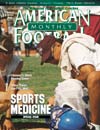AMERICAN FOOTBALL MONTHLY THE #1 RESOURCE FOR FOOTBALL COACHES
Article CategoriesAFM Magazine
|
The BasicsWhat teams need for an adequate athletic training programby: Valerie Hunt National Athletic Trainers\' Association © More from this issue It's been called the sick tank, the warm-up room - and in at least one case, the wildlife sanctuary. It's where players go to prepare for battle and where they return to let their game faces down as they confront the pain of injury. It's not a simple place. The athletic training room, even in its most basic form, is a microcosm unto itself. Building one entails careful attention to the structural requirements, which are more detailed than finding four walls and a ceiling. Building a sports medicine program to fill that room is even more complicated. Many coaches, however, find themselves with the responsibility of creating and maintaining just such a room. But, where do they start? What to do? A coach can start with the six basic components of an athletic training room: personnel, education, structural facilit....The full article can only be seen by subscribers.
|
|
|||||||
| HOME |
MAGAZINE |
SUBSCRIBE | ONLINE COLUMNISTS | COACHING VIDEOS |
Copyright 2025, AmericanFootballMonthly.com
All Rights Reserved





